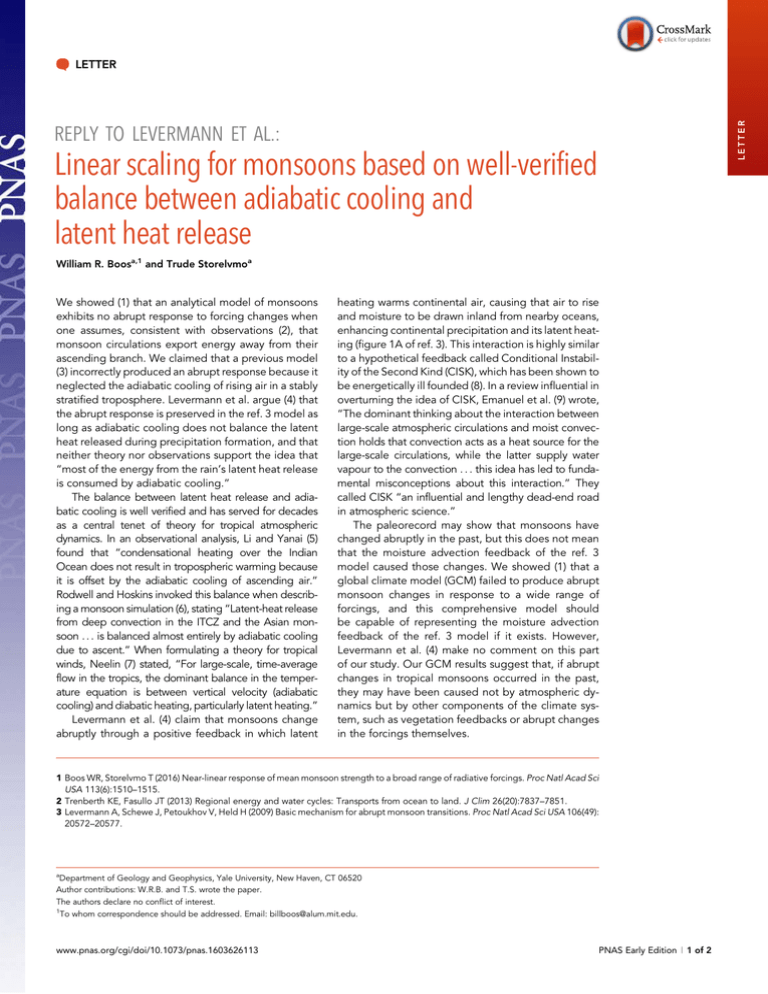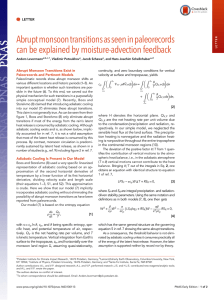Linear scaling for monsoons based on well-verified latent heat release
advertisement

LETTER LETTER REPLY TO LEVERMANN ET AL.: Linear scaling for monsoons based on well-verified balance between adiabatic cooling and latent heat release William R. Boosa,1 and Trude Storelvmoa We showed (1) that an analytical model of monsoons exhibits no abrupt response to forcing changes when one assumes, consistent with observations (2), that monsoon circulations export energy away from their ascending branch. We claimed that a previous model (3) incorrectly produced an abrupt response because it neglected the adiabatic cooling of rising air in a stably stratified troposphere. Levermann et al. argue (4) that the abrupt response is preserved in the ref. 3 model as long as adiabatic cooling does not balance the latent heat released during precipitation formation, and that neither theory nor observations support the idea that “most of the energy from the rain’s latent heat release is consumed by adiabatic cooling.” The balance between latent heat release and adiabatic cooling is well verified and has served for decades as a central tenet of theory for tropical atmospheric dynamics. In an observational analysis, Li and Yanai (5) found that “condensational heating over the Indian Ocean does not result in tropospheric warming because it is offset by the adiabatic cooling of ascending air.” Rodwell and Hoskins invoked this balance when describing a monsoon simulation (6), stating “Latent-heat release from deep convection in the ITCZ and the Asian monsoon . . . is balanced almost entirely by adiabatic cooling due to ascent.” When formulating a theory for tropical winds, Neelin (7) stated, “For large-scale, time-average flow in the tropics, the dominant balance in the temperature equation is between vertical velocity (adiabatic cooling) and diabatic heating, particularly latent heating.” Levermann et al. (4) claim that monsoons change abruptly through a positive feedback in which latent heating warms continental air, causing that air to rise and moisture to be drawn inland from nearby oceans, enhancing continental precipitation and its latent heating (figure 1A of ref. 3). This interaction is highly similar to a hypothetical feedback called Conditional Instability of the Second Kind (CISK), which has been shown to be energetically ill founded (8). In a review influential in overturning the idea of CISK, Emanuel et al. (9) wrote, “The dominant thinking about the interaction between large-scale atmospheric circulations and moist convection holds that convection acts as a heat source for the large-scale circulations, while the latter supply water vapour to the convection . . . this idea has led to fundamental misconceptions about this interaction.” They called CISK “an influential and lengthy dead-end road in atmospheric science.” The paleorecord may show that monsoons have changed abruptly in the past, but this does not mean that the moisture advection feedback of the ref. 3 model caused those changes. We showed (1) that a global climate model (GCM) failed to produce abrupt monsoon changes in response to a wide range of forcings, and this comprehensive model should be capable of representing the moisture advection feedback of the ref. 3 model if it exists. However, Levermann et al. (4) make no comment on this part of our study. Our GCM results suggest that, if abrupt changes in tropical monsoons occurred in the past, they may have been caused not by atmospheric dynamics but by other components of the climate system, such as vegetation feedbacks or abrupt changes in the forcings themselves. 1 Boos WR, Storelvmo T (2016) Near-linear response of mean monsoon strength to a broad range of radiative forcings. Proc Natl Acad Sci USA 113(6):1510–1515. 2 Trenberth KE, Fasullo JT (2013) Regional energy and water cycles: Transports from ocean to land. J Clim 26(20):7837–7851. 3 Levermann A, Schewe J, Petoukhov V, Held H (2009) Basic mechanism for abrupt monsoon transitions. Proc Natl Acad Sci USA 106(49): 20572–20577. a Department of Geology and Geophysics, Yale University, New Haven, CT 06520 Author contributions: W.R.B. and T.S. wrote the paper. The authors declare no conflict of interest. 1 To whom correspondence should be addressed. Email: billboos@alum.mit.edu. www.pnas.org/cgi/doi/10.1073/pnas.1603626113 PNAS Early Edition | 1 of 2 4 Levermann A, Petoukhov V, Schewe J, Schellnhuber HJ (2016) Abrupt monsoon transitions as seen in paleorecords can be explained by moisture-advection feedback. Proc Natl Acad Sci USA, 10.1073/pnas.1603130113. 5 Li C, Yanai M (1996) The onset and interannual variability of the Asian summer monsoon in relation to land-sea thermal contrast. J Clim 9(2):358–375. 6 Rodwell MJ, Hoskins BJ (1996) Monsoons and the dynamics of deserts. Q J R Meteorol Soc 122(534):1385–1404. 7 Neelin JD (1988) A simple model for surface stress and low-level flow in the tropical atmosphere driven by prescribed heating. Q J R Meteorol Soc 114(481): 747–770. 8 Arakawa A (2004) The cumulus parameterization problem: Past, present, and future. J Clim 17(13):2493–2525. 9 Emanuel KA, Neelin DJ, Bretherton CS (1994) On large-scale circulations in convecting atmospheres. Q J R Meteorol Soc 120(519):1111–1143. 2 of 2 | www.pnas.org/cgi/doi/10.1073/pnas.1603626113 Boos and Storelvmo


